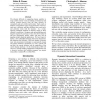Free Online Productivity Tools
i2Speak
i2Symbol
i2OCR
iTex2Img
iWeb2Print
iWeb2Shot
i2Type
iPdf2Split
iPdf2Merge
i2Bopomofo
i2Arabic
i2Style
i2Image
i2PDF
iLatex2Rtf
Sci2ools
AAAI
2000
2000
Adaptive User Interfaces through Dynamic Design Automation
The inherent difficulty in supporting human usability in large control systems--such as building environmental and security systems--derives from the large diversity of components and users within each domain. Each system is different, with different types and organizations of devices; each user is different, and takes different roles; each task a user performs varies with the situation. As a result, applying traditional methods of interface design to these systems is insufficient. Designers end up handcrafting each diagram required by each type of user, the effort needed to add new functionality quickly bloats, and users end up juggling multiple disparate applications. We have begun to deploy a tool called DIG (Dynamic Interaction Generation) that addresses this difficulty. DIG uses models of domain, task, and presentation knowledge to automatically design and present interfaces specialized to a user's current role and task, the current situation, and the capabilities of the cur...
| Added | 01 Nov 2010 |
| Updated | 01 Nov 2010 |
| Type | Conference |
| Year | 2000 |
| Where | AAAI |
| Authors | Robin R. Penner, Erik S. Steinmetz, Christopher L. Johnson |
Comments (0)

